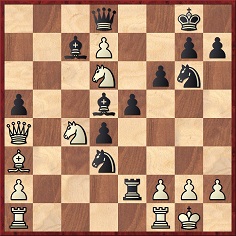
Edward Winter
The present article complements Chess Openings and draws together a miscellany of C.N. items which have discussed seldom-seen openings.
***
Should the following game be labelled ‘The Immortal Damiano’ or, perhaps, the only good Damiano ever played?
R. Münz – Josef Emil Krejcik
Vienna, 7 May 1911
Damiano’s Defence
1 e4 e5 2 Nf3 f6 3 Bc4 b5 4 Bxb5 Bb7 5 Nc3 c6 6 Bc4 d5 7 exd5 cxd5 8 Bb5+ Nd7 9 O-O Bd6 10 d3 Ne7 11 Ne2 O-O 12 Ng3 Nc5 13 Be3 Ne6 14 c4 d4 15 Bd2 Ng6 16 Ne4 Bc7 17 c5 Bd5 18 Qa4 Rb8 19 Bd7 Rxb2 20 Bb4 a5 21 Ba3 Re2 22 c6 Rf7 23 Nfd2 Nef4 24 Nc4 Nxd3 25 Ned6 Rxd7 26 cxd7

26...Bxg2 27 Qb3 (The Wiener Schachzeitung analyzes 27 Kxg2 Nh4+ and wins.) 27...Bd5 28 Qxd3 Nf4 29 Qg3 Rc2 30 Rfe1 Qxd7 31 f3 Qh3 32 Qxh3 Nxh3+ 33 White resigns.
Source: Wiener Schachzeitung, July-August 1912, pages 199-200.
(357)
A new book from the USA provides the largest collection yet of Fischer’s games (942, most with brief notes): Bobby Fischer: Complete Games of the American World Chess Champion compiled and edited by Lou Hays. The section on simultaneous encounters offers a number of surprises, such as a game in which Fischer was held to a draw against Damiano’s Defence:
Robert James Fischer (simultaneous) – R.F. McGregor
Houston, 28 March 1964
Damiano’s Defence
1 e4 e5 2 Nf3 f6 (‘Bluffing. McGregor, actually a strong player, wanted Fischer to think he was a beginner.’) 3 Nxe5 Qe7 4 Nf3 d5 5 d3 dxe4 6 dxe4 Qxe4+ 7 Be2 Bf5 8 Nd4 Nc6 9 Nxf5 Qxf5 10 O-O Bd6 11 Bg4 Qb5 12 Nc3 Qc4 13 Be2 Qf7 14 Bb5 O-O-O 15 Qg4+ f5 16 Qh3 Nge7 17 Ne4 h6 18 Nxd6+ Rxd6 19 Bf4 Rd4 20 Be3 Rb4 21 Bxc6 Nxc6 22 b3 Re4 23 Rfd1 Rd8 24 Rxd8+ Nxd8 25 Rd1 Qe6 26 g3 Rxe3 Drawn.
It is notable that Fischer did not play the gambit line recommended by the Wiener Schachzeitung (May-June 1912, page 179, and July-August, page 200): 8 O-O (‘!’) Qxc2 9 Qe1 Be7 10 Nc3 Nc6 11 Bb5 O-O-O 12 Qe3, with the threat of 13 Ne1. The magazine also pointed out the snap finish 8 O-O Qxc2 9 Re1 Qxd1 10 Bb5+ Kf7 11 Be8 mate, but of course after 10...Kd8 there is no mate at e8 because the rook is pinned. Fischer’s 8 Nd4 line was preferred by earlier opening encyclopaedias; the 1843 edition of Bilguer’s Handbuch des Schachspiels (pages 48-49) gave 8 Nd4 Nc6 9 Nxf5 Qxf5 10 O-O Bd6 11 Bd3.
As always in such cases, we wonder how much knowledge the master had, and needed, of this historical background.
(1934)
Paul Timson (Whalley, England) tells us that the latest Pergamon Chess Bulletin, reviewing M. Basman’s book Play the St George, contains the following blunder:
‘The most famous victory using this opening was Karpov’s defeat by Miles in the 1980 European Team Championship, the first time that a British champion has defeated a reigning world champion.’
The ‘first time’ bit is, naturally, nonsense (Blackburne v Lasker at Hastings, 1895 and London, 1899; Penrose v Tal at Leipzig, 1960 ...). A strange mistake considering that such previous British successes have also been hyped to the sky.
(256)
Play the St George by Michael Basman (Pergamon Press) contains a fascinating chapter (pages 98-106) on the occasion when a player named J. Baker played 1 e4 a6 against both Blackburne and Steinitz on the same day. We need not repeat the games here since they also appear on page 414 of the September 1982 BCM.
What surprised us in Basman’s book was to find no reference to the fact that 1 e4 a6 has also been known as the Ryan Opening. According to the Dictionnaire des échecs the attribution derives from a game Mackensie [sic] v Ryan, 1884. Without having the score to this game, or information about the occasion, we guess that White was G.H. Mackenzie (1837-91), a Scotsman who emigrated to the United States in the 1860s, and that Black was John S. Ryan, listed in Gaige’s USA Personalia as ‘fl. 1890s in New York’.
It may be noted too that 1 d4 a6 was even played in the great St Petersburg tournament of 1914; Rubinstein v Gunsberg – White won in 34 moves. [Detailed material by Myers is quoted in the Basman book.] See also the August 1977 BCM, page 379. As regards nomenclature, Baker’s Defence seems far the best choice. The reasons for dragging in St George are paper-thin, but it is probably too late now to drag him out.
(393)
Addition on 25 August 2022:
John S. Hilbert (Amherst, NY, USA), who is preparing a book on G.H. Mackenzie, has sent us the following game-score:
George Henry Mackenzie – John S. Ryan
Manhattan Chess Club Handicap Tournament (even game), 1883
Irregular Defence
1 e4 a6 2 d4 e6 3 Bd3 c5 4 c3 b5 5 Be3 cxd4 6 cxd4 Bb7 7 Ne2 Nf6 8 f3 Bb4+ 9 Nd2 O-O 10 O-O h6 11 Rc1 Nc6 12 a3 Ba5 13 Bb1 Bb6 14 Bf2 Rc8 15 e5 Nd5 16 Ne4 Nde7 17 Nd6 Rb8 18 Qd3 g6 19 Kh1 Nf5 20 Ne4 Rc8 21 g4 Nfe7 22 Bh4 Kg7 23 Nd6 Rb8 24 Bf6+ Kh7 25 h4 Ba7 26 Kg2 Qb6 27 h5 Rg8 28 Rh1
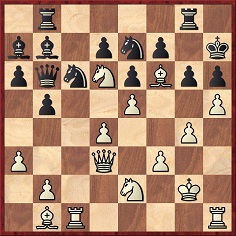
28...Nf5 29 hxg6+ Rxg6 30 Nxf5 exf5 31 Rxh6+ Rxh6 32 Qxf5+ Kg8 33 Qg5+ Rg6 34 Rh1 Resigns.
Source: Brooklyn Chess Chronicle, 15 January 1884, pages 60–61.
An earlier game which began 1 e4 a6 is on pages 175-176 of the 15 June 1881 issue of La Stratégie: a blindfold loss by Colonel C. Scheletti against an amateur in Bucharest on 3 May 1881.
1...f6 must be one of the very weakest replies to the king’s pawn opening, yet occasionally it is seen in master praxis. Barnes won with it against Morphy in 1858, although the move failed to serve him well against Anderssen in London four years later. The next occurrence of 1 e4 f6 that we have been able to find is Marco-Winawer in the fifth round of the Berlin, 1897 tournament. White won in 61 moves. Any others?
(451)
From Ken Neat (Durham, England):
‘A recent issue of Shakhmaty (Riga) reports on a thematic correspondence tournament in 1981-83 in which all the games started 1 d4 f6. The correspondent S. Grodzensky suggests that the critical continuation is 2 e4 e5!? 3 dxe5 Bc5 4 Bc4 Qe7 5 Bxg8 Rxg8 6 Nf3, when White’s position is preferable.’
The only 1 e4 f6 game we have seen since writing C.N. 451 is Schneider-Perna, Dresden, 1892 (pages 236-237 of the tournament book).
(1250)
See too C.N. 6014.
The game between Paulsen and von Gottschall at Dresden, 1892 (see page 209 of the tournament book) opened 1 h3. Play continued 1...e5 2 c4 Nc6 3 e3 Nf6 4 a3 d5, and Black won at move 32.
(751)
An endnote on page 260 of Chess Explorations:
1 h3 is known as the Clemenz Opening. Hermann Clemenz used it in a miniature played at a six-board blindfold exhibition in St Petersburg in 1873 (La Stratégie, 15 February 1881 page 52).
The euphemistic term ‘Irregular Opening’ hardly does justice to White’s freakish path to a speedy victory:
J.A. Anderson – N.N.
St Louis, 1929
Irregular Opening
1 h3 g6 2 g3 Bg7 3 f3 Nf6 4 e3 O-O 5 d3 d5 6 c3 e5 7 b3 Nh5 8 Kf2 Qg5 9 Ne2 Bf5 10 a3 e4 11 f4 Qh6 12 g4 exd3 13 g5 dxe2 14 Bxe2 Resigns.
Source: The Gambit, August 1929, page 240.
(Kingpin, 1996)
Tom Testa (Alameda, CA, USA) sends us Koltanowski’s column in the San Francisco Chronicle of 10 October 1988, which gives ‘Christian Bleis v Horst Alber, West Germany, 1988’ featuring a strange opening: 1 d4 Nf6 2 c4 Rg8 3 Nc3 g5 4 e4 d6 5 f4 gxf4 6 Bxf4 Nc6 7 e5 Bg4. White was mated at move 20. Koltanowski writes that 3 h4 might have been considered.
On the subject of irregular openings, we note the following by Eugene Delmar:
a) 1 e4 Na6 2 Bxa6 bxa6 3 d4 e6 4 Nf3 Bb7 5 d5 exd5 6 exd5 Nf6 7 c4 Bb4+ 8 Nc3 O-O (J.F. Magee-E. Delmar, Manhattan Chess Club v Franklin Chess Club, 30 May 1906). A draw was agreed after 37 moves. Source: American Chess Bulletin, June 1906, page 110.
b) 1 b4 e5 2 Bb2 Nc6 (‘A serious oversight, due to hasty play.’) 3 b5 Nce7 4 Bxe5, etc. (E. Delmar-F.J. Marshall, Brooklyn Chess Championship, 1906). Source: American Chess Bulletin, August 1906, page 164. Could this be a unique example of a leading player blundering at move two? (White won in 43 moves.)
c) 1 e4 Nh6 2 d4 g6 3 Nf3 f6 4 Bd3 Nf7 5 Nc3 e6 6 Be3 d5 7 Qe2 c6 8 O-O Be7 (S.W. Bampton-E. Delmar, Manhattan Chess Club v Franklin Chess Club, 30 May 1907). The score continues to 48 Kh2 Rxa3 ‘and Black won’. Source: American Chess Bulletin, July 1907, page 135.
d) 1 Nh3 d5 2 g3 e5 3 f3 Bd6 4 Nf2 Nf6 5 e3 O-O 6 Bg2 Be6 7 d3 Nc6 8 O-O Qd7 (E. Delmar-S.T. Sharp, Rice Trophy Tournament, 1908. The game was drawn in 54 moves. Source: American Chess Bulletin, August 1908, page 159.
(1745)
An endnote on page 261 of Chess Explorations:
Stefan Bücker (Nordwalde, Germany) has provided an earlier publication of the Bleis-Alber game: page 71 of the 24 July 1988 issue of Karl.
C.N. 1745 above mentioned a game which began 1 d4 Nf6 2 c4 Rg8. A worthy addition is ‘Duffre’s Defence’, which appeared in a satirical article by R.J. French, ‘Game Preserving’, on pages 27-28 of the October 1922 Chess Amateur: 1 e4 e5 2 Nf3 Nc6 3 Rg1.
(8523)
The following game, which appeared in the chess column of the Cincinnati Commercial in 1881, is notable for a bizarre third move (claimed at the time to be a unique occurrence) and the sacrifice of all White’s king-side pawns by move six.
I.E. Orchard – J.S.R. Thomson
USA, 1881
King’s Gambit Accepted
1 e4 e5 2 f4 exf4 3 g3 fxg3 4 Nf3 gxh2 5 Bc4 Nf6 6 Rxh2 Nxe4 7 Re2 d5 8 Bxd5 Qxd5 9 Nc3 Qh5 10 Nxe4 Qh1+ 11 Kf2 Qxd1 and White mated in two.
(Kingpin, 1992)
The game was also published on page 262 of the Chess Player’s Chronicle of 31 May 1881. That source specifies that the winner, I.E. Orchard, christened his third move the ‘Palmetto Gambit’ in honour of his native state, South Carolina. In a letter on page 290 of the June 1881 issue of the Chronicle F.V. of Southsea reported that he had played White in a game beginning 1 e4 e5 2 f4 exf4 3 g3 fxg3 4 Nf3; after 4…d5 5 exd5 Qxd5 6 Nc3 Qe6+, he was two pawns down and his attack had been neutralized. On the same page, another correspondent, J.S.E. of Liverpool, pointed out that far from being a novelty, 3 g3 was ‘noticed curtly’ on page 392 of the most recent edition of the Handbuch. The continuation given was 3...fxg3 4 hxg3 d5, and ‘Black has the better game’. The Chronicle sniffily suggested that ‘the “newly invented gambit” is meant as another of those practical jokes for which our American cousins are so justly celebrated’.
(Kingpin, 1996)
A game from the chess column (by Mrs Rowland) in The Warder of 21 December 1889:
‘Merry Skirmishes
(...)
The shortest game on record.
Played in Dublin in 1867, Black giving the odds of KBP.
Mr Leeky-Dr Mason
1 e4 g5 (a)
2 Qh5 mate (b).
Notes – (a) ? (b) !’
(Kingpin, 2000)
From an article by Alekhine on pages 347-348 of CHESS, 14 May 1936:
‘The following game was played in the spirit of burlesque. And why not? Is it wicked to play chess light-heartedly? My opponent requested that his name, as conductor of the black pieces, be not handed down to posterity and I am sure nobody will blame him!
White: A. Alekhine – Black: …
1 e4 e5 2 d4 f6? (The simplest way of virtually losing a game in two moves.) 3 dxe5 fxe5?? (Not to be generally recommended, but quite in harmony with the plan of the preceding move. 3…Qe7 would have been better.) 4 Qh5+ Ke7 5 Qxe5+ Kf7 (Best, since any other move would have been illegal.) 6 Bc4+ d5 (A sudden change of plan. 6…Kg6 would have allowed a mate on the move.) 7 Bxd5+ Kg6 8 Qg3+ (The challenge to White is to force mate in the minimum number of moves and I think it was satisfactorily taken up.) 8…Kh5 9 Bf7+ g6
10 h3 (Threatening to mate in three moves by 11 Qg4+ Bxg4 12 hxg4+ and 13 Be6 mate.) 10…Qf6 11 Nf3 Be7
(Now White announced mate in six moves and I want you to find out how it was done.)’
The solution was given on page 360 of the same issue: 12 Qg4+ Bxg4 13 hxg4+ Kxg4 14 Nh2+ Kh5 15 Nf1+ Kg4 16 Be6+ Qxe6 17 f3 mate.
In the following issue of CHESS (14 June 1936, page 365) a reader, Mr Raymond of Weymouth, pointed out an alternative mate in six in the final position, starting with 12 Qe5+, but that page contained a worse affront to Alekhine’s satisfaction with his play: S.G. Luckcock showed that at an earlier stage the former world champion had missed a much quicker mate. As indicated on page 396 of the magazine, after the first diagram above Alekhine could have played 10 Qe5+ Bf5 11 Qxf5+ Kh4 12 g3 mate. If 10…Kg4 12 h3+ etc. and if 10…Kh4 11 g3+ etc.
Alekhine did not give the date or venue for this game, but on page 556 of the Skinner/Verhoeven book on Alekhine these were specified as ‘the Café Schneider, Mödling, 24 March 1936’.
(Kingpin, 2001)
See too pages 100-101 of A Chess Omnibus. A footnote on page 100 commented that at move 10 White was, in fact, threatening mate in two moves (with 11 Qf3+), and not three.
(2638)
This game was published on page 90 (misnumbered 80) of the Chess Player’s Chronicle, 20 August 1884, being taken from the New York Clipper:
Preston Ware, Jr. – F.J. Keyes
Occasion?
‘Popcorn Opening’
1 f3 f6 2 e3 e6 3 c3 c6 4 d4 d5 5 Bd3 Bd6 6 f4 f5 7 Nf3 c5 8 O-O c4 9 Bc2 Nf6 10 Ne5 O-O 11 Nd2 Nc6 12 Ndf3 Qe8 13 Bd2 Ne4 14 Be1 h6 15 g4 fxg4 16 Nxg4 Qg6 17 Nfe5 Nxe5 18 dxe5 Bc5 19 Qf3 h5 20 h3 hxg4 21 Qxg4 Qf5 22 Kh2 Bd7 23 Qf3 Ng5 24 Qg2 Ne4 25 Rf3 Be8 26 Rg3
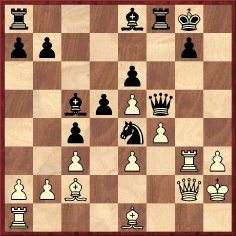
26...Nxg3 27 Bxf5 Nxf5 28 e4 Ne3 29 Qf3 dxe4 30 Qxe4 Bc6 31 Qg6 Nf1 mate.
(4433)
On page 313 of the July-August 1934 issue of Les Cahiers de l’Echiquier Français Tartakower wrote that Barnes’ Opening (1 f3) could gain recognition if two ‘arbitrary’ chess rules were abolished: the double pawn-move and castling.
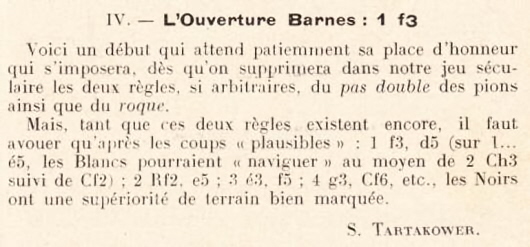
(8240)
In a ten-board blindfold exhibition in Milan on 25 March 1923 Alekhine lost a game to L. Morelli, who played the gambit 1 e4 d5 2 exd5 c6 3 dxc6 Qc7 4 cxb7 Bxb7. For the full score see page 187 of the Skinner/Verhoeven book on Alekhine.
We note that some two years previously Morelli had played the same opening, with less success:
E. Mildmay – Luca Morelli
Milan, 1921 (?)
Center Counter Game
1 e4 d5 2 exd5 c6 3 dxc6 Qc7 4 cxb7 Bxb7
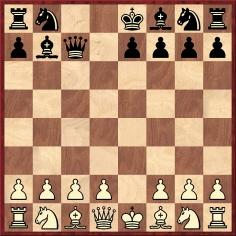
5 d4 Nf6 6 c3 Nc6 7 Be3 e5 8 Nf3 e4 9 Nfd2 Bd6 10 Nc4 Bxh2 11 g3 Bxg3 12 fxg3 Qxg3+ 13 Bf2 Qc7 14 Nbd2 O-O-O 15 Bh3+ Kb8 16 Qb3 Qf4 17 Rg1 Ka8 18 Bg3 Qh6 19 Bg2 e3 20 Ne4 Nxd4
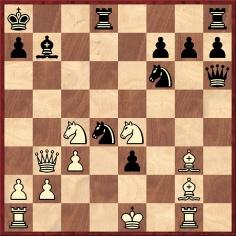
White announced mate in three: 21 Qxb7+ Kxb7 22 Nc5+ Kc8 23 Bb7 mate.
Our source is pages 74-75 of the May 1921 Schweizerische Schachzeitung:
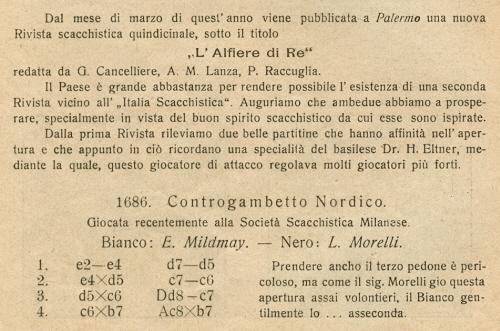
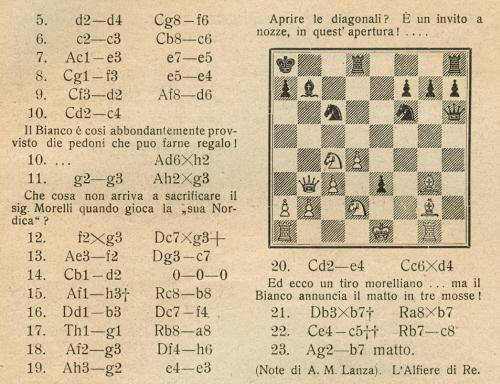
(6903)
The game below was given in C.N. 1368:
Luis R. Díaz – Miguel Valladares1 Nf3 e5 2 Nxe5 Nc6 3 Nxc6 dxc6 4 d4 Bd6 5 e4 Qh4 6 Nc3 Bb4 7 Bd3 Nf6 8 Bd2 Bxc3 9 Bxc3 Nxe4 10 Qe2
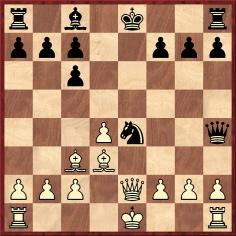
10...f5 11 O-O O-O 12 g3 Qh3 13 Bxe4 fxe4 14 Qxe4 Bf5 15 Qf4 Bg4 16 White resigns.
Source: Jaque Mate, 7-8/1973, page 66.
C.N. 2454 (see page 173 of A Chess Omnibus) pointed that although Jaque Mate had used the term ‘Valladares Opening’, a game between von Scheve and Silbert at the Café de la Régence in Paris on 24 October 1902 had begun 1 Nf3 e5 2 Nxe5 d5 3 d4 Bd6. Janowsky called Black’s first move ‘a very rare error in a tournament game’ (La Stratégie, 21 January 1903, pages 4-5). Moreover, 1…e5 in reply to 1 Nf3 was played even by Emanuel Lasker, in a 1907 simultaneous game (a win) in Topeka. He published it – under the heading ‘Opening: (Original!)’ – on page 151 of the August 1907 issue of Lasker’s Chess Magazine.
(7161)
C.N. 6861 quoted from page 236 of the May 1891 BCM:
‘One popular character at Purssell’s is Mr Manley, a good old Purssellite, who is best known by his “rat” openings (P to Kt3 and B to Kt2).’
It was not specified whether the moves were played by him as White and/or Black. Below is an entry on page 170 of the Dictionary of Modern Chess by Byrne J. Horton (New York, 1959):
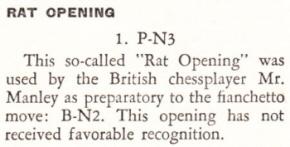
On page 148 of the July 1965 Chess Life John W. Collins wrote:
‘As for 1 P-K4, or 1 P-Q4, P-KN3 2 P-Q4, or 1 P-K4 P-Q3, who knows what to call it? Some say it is the King’s Fianchetto, some the Paulsen, some the Pirc, some the Robatsch, and some the Ufimtsev. Bobby Fischer once dubbed it the Rat Defense.’
Whether Fischer did ‘once’ dub the opening in that way (publicly) seems unclear. The only reference that we can offer is from a game annotated by him on pages 44-45 of the February 1964 Chess Life:

The game-reference in the first paragraph after 4...c6 is also notable.
(8385)
Fred Brown acquired some fame for playing 1 g4. A well-known game is his 27-move win against Louis van Vliet, London, 1904. From page 8 of the Manchester Courier and Lancashire General Advertiser, 13 August 1904:
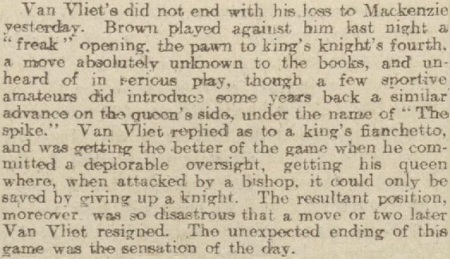
1 g4 had also been played by Fred Brown against Amos Burn in the Midland Counties Congress in Birmingham in 1899. The game, which Brown lost, is on pages 533-534 of Richard Forster’s monograph on Burn, with notes from the Birmingham Daily Post, 11 April 1899.
Another score from the same tournament:
Fred Brown – George Edward H. Bellingham
Birmingham, April 1899
Irregular Opening
1 g4 e5 2 Bg2 d5 3 h3 c6 4 d3 Bc5 5 Nc3 f5 6 gxf5 Bxf5 7 Nf3 d4 8 Ne4 Bxe4 9 dxe4 Nd7 10 Bg5 Ngf6 11 Nd2 Qb6 12 Rb1 Nf8 13 Bh4 Ng6 14 Bg3 Nh5 15 O-O Ngf4
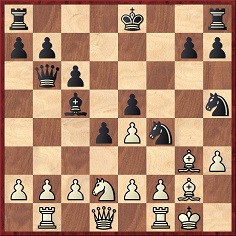
16 b4 Be7 17 Kh2 O-O 18 Bf3 Rad8 19 Rb3 Nxg3 20 fxg3 Ng6 21 a3 Qc7 22 Bg4 Rf6 23 Rbf3 a5 24 Qb1 axb4 25 axb4 Nf8 26 Nc4 b5 27 Nd2 Ra8 28 Rxf6 gxf6 29 Qb3+ Kg7 30 Nf3 Bd8 31 Nh4 Ra7 32 Nf5+ Kh8 33 Bh5 Ng6 34 c3 c5 35 bxc5 Qxc5 36 cxd4 exd4 37 Qe6 Qe5 38 Qc6 b4 39 Rd1 Be7 40 Rxd4 Nf8 41 Qc4 Rc7 42 Qa2 Bc5 43 Rd5 Qe6 44 Bg4 Qb6 45 Rd1 b3 46 Qb2 Nd7 47 Kg2 Rb7 48 Nh6 Ne5 49 Rc1 Rb8 50 Nf5 Qb4 51 Bf3 Qa5 52 Ra1 Qb6 53 Rc1 Qa7 54 Ra1 Qf7 55 Rb1
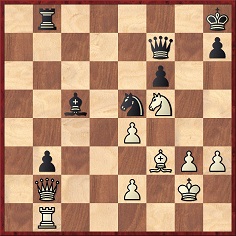
55...Nc4 56 Qc3 b2 57 Bh5 Qe6 58 Bf3 Rb3 59 Qc2 Rb4 60 g4 Qxf5 61 exf5 Ne3+ 62 Kg3 Nxc2 63 White resigns.
Sources: La Stratégie, 15 May 1899, pages 141-142, and the Chess Player’s Chronicle, 24 May 1899, pages 127-128. Both magazines gave the notes by L. Hoffer in The Field.
The game H.E. Atkins v Fred Brown in the Birmingham tournament began 1 d4 b5 2 e4 a6 (Chess Player’s Chronicle, 19 April 1899, pages 70-72).
For Zukertort’s reaction when 1 g4 was played against him in an exhibition (Louisville, 1883), see C.N. 7112.
(9795)
Alan Smith (Stockport, England) submits a game from page 780 of The Field, 12 November 1898:
Fred Brown – Arthur John Mackenzie
Birmingham, 1898
Irregular Opening
1 g4 d5 2 h3 e5 3 Bg2 c6 4 d3 Bc5 5 Nf3 Qc7 6 Nc3 Be6 7 e4 Nd7 8 O-O O-O-O 9 Bg5 f6 10 Bh4 g5 11 Bg3 Ne7
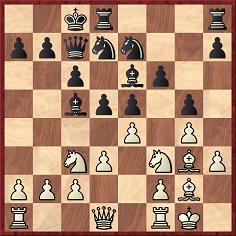
12 d4 Bd6 13 Qe2 h5 14 exd5 Nxd5 15 Nxd5 cxd5 16 dxe5 Nxe5 17 Nd4 Bd7 18 Nf5 hxg4 19 hxg4 Bxf5 20 gxf5 Qh7 21 Rfd1 Qxf5 22 Rxd5 Bc7 23 Rad1 Rxd5 24 Rxd5 Rd8 25 Rb5 b6 26 Rb3 Rd4 27 Rc3 Kd8 28 Qh5 Bd6 29 Qh8+ Ke7 30 Qg7+ Nf7 31 Bxd6+ Rxd6 32 Re3+ Re6 33 Bh3 g4 34 Bxg4 Rxe3 35 Bxf5 Re5 36 Bg6 Resigns.
(9804)
‘No first move can be bad.’
Source: pages 165-166 of the March 1927 Chess Amateur. In the Games Department, conducted by Charles R. Gurnhill, it was a comment about 1 Nf3 in the game A. Teller v G.M. Norman, Hastings, 4 January 1927.
(11782)
From pages 17-18 of the Columbia Chess Chronicle, 16 July 1887:
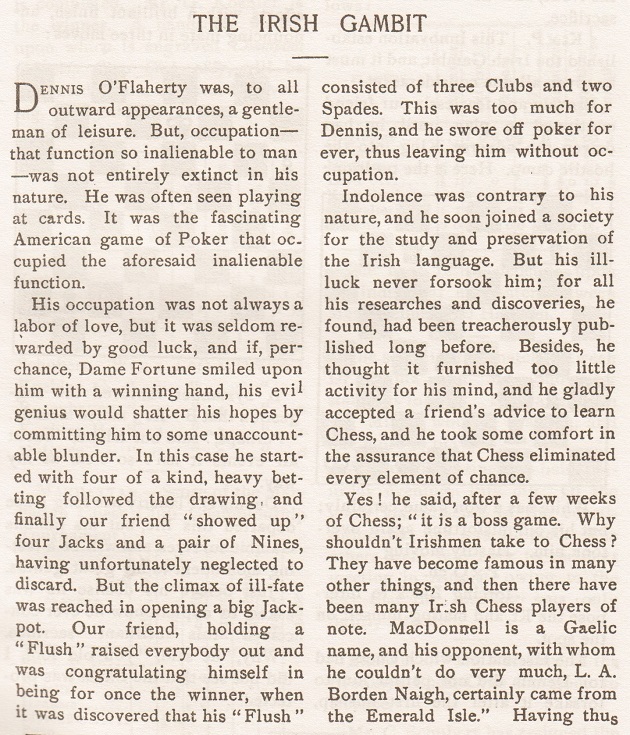
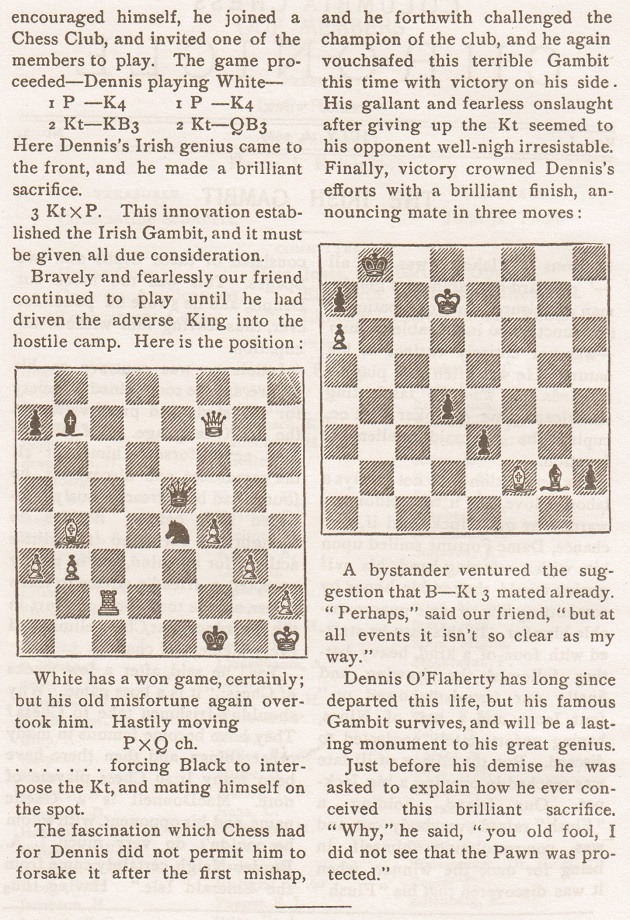
The best-known game beginning 1 e4 e5 2 Nf3 Nc6 3 Nxe5 is D.T. Phillips v H.N. Pillsbury, Chicago, 7 January 1899, published on page 12 of the Brooklyn Daily Eagle, 26 January 1899:
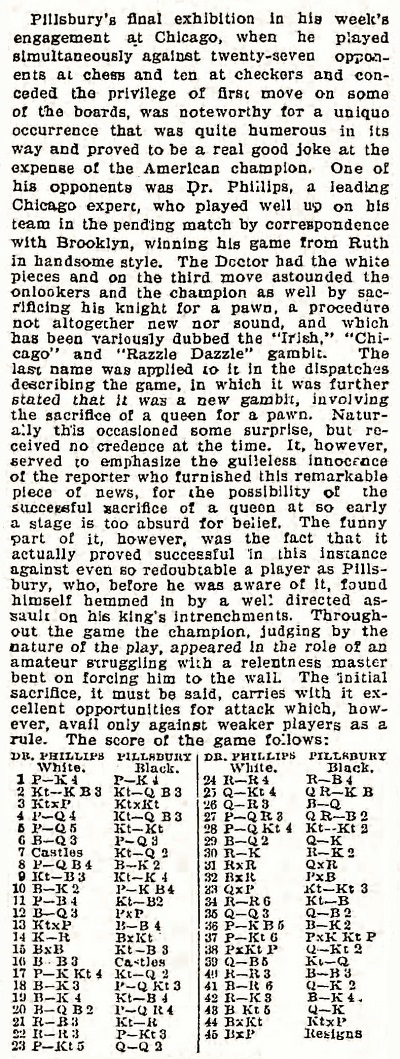
See too page 345 of the American Chess Magazine, February 1899, which was our source in C.N. 1985 (page 69 of Kings, Commoners and Knaves.
(10890)
On 15 September 2002 Hugh Myers (Davenport, IA, USA) sent us his win against Jason Juette in Iowa City earlier that month:
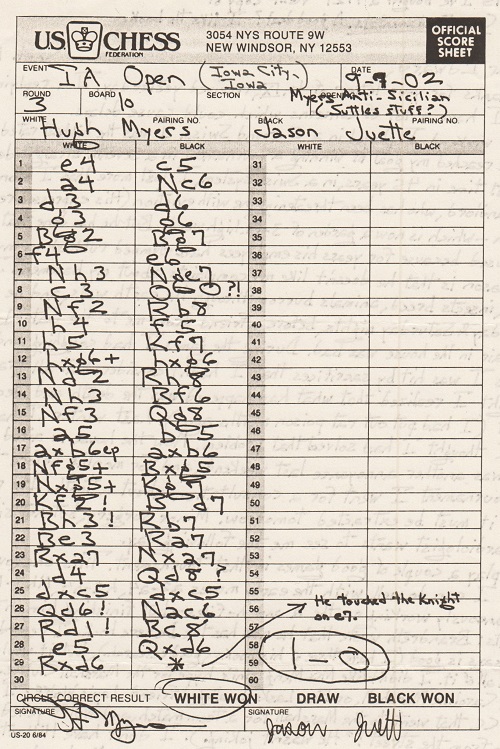
1 e4 c5 2 a4 Nc6 3 d3 d6 4 g3 g6 5 Bg2 Bg7 6 f4 e6 7 Nh3 Nge7 8 c3 O-O 9 Nf2 Rb8 10 h4 f5 11 h5 Kf7 12 hxg6+ hxg6 13 Nd2 Rh8 14 Nh3 Bf6 15 Nf3 Qg8 16 a5 b5 17 axb6 axb6 18 Nfg5+ Bxg5 19 Nxg5+ Kg7
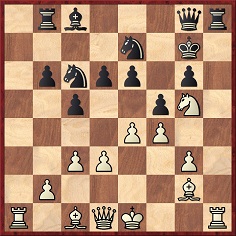
20 Kf2 Bd7 21 Bh3 Rb7 22 Be3 Ra7 23 Rxa7 Nxa7 24 d4 Qd8 25 dxc5 dxc5 26 Qd6 Nac6 27 Rd1 Bc8 28 e5 Qxd6 29 Rxd6.
Overleaf, Hugh Myers, who was aged 72 at the time, commented to us that the game ‘... shows again that I can do well with the early moves a2-a4, h2-h4, Nh3-Nf2-Nh3, and then simultaneously working on the a and h-files – but finishing him on the d-file’.
(11852)
To the Chess Notes main page.
To the Archives for other feature articles.
Copyright: Edward Winter. All rights reserved.